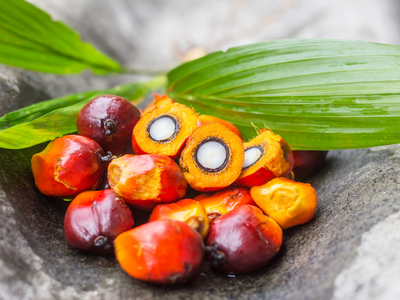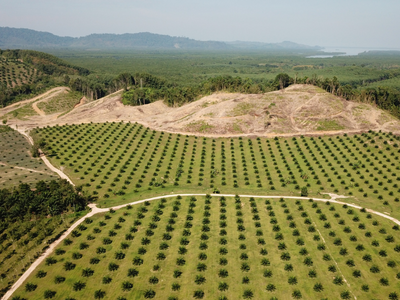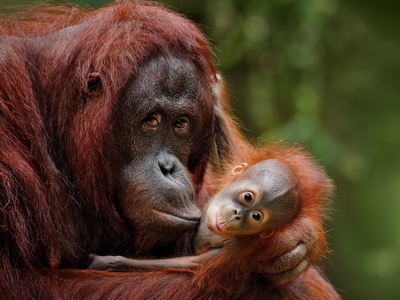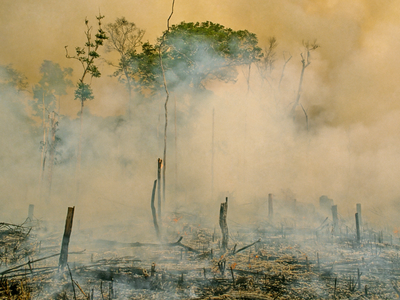
Why is Palm Oil Bad?
Palm oil is bad because it is harmful to the environment. The industry has a history of unsustainable farming practices, unfair labor practices, and had been the cause of wide-scale deforestation. The mono-culture farming and production practices of the palm oil industry not only ruin the area's rich biodiversity, it has caused the killing of animals and destruction of habitats of many endangered species.
These days, palm oil is everywhere. That might sound like an exaggeration, but head to the grocery store and you’ll discover it is in some of your favorite treats. From chocolate to chips, ice cream to noodles and crackers, palm oil is in more than 50% of pre-packaged food items because it is a cheap filler and substitute for more expensive fats. In chocolate, it results in a confection that doesn't taste as good.
What is palm oil?
Palm oil is a vegetable oil that comes from the fruit of the palm tree. There are two different kinds of vegetable oils that can be harvested from palm trees; palm kernel oil (which is inedible) and palm oil (which is edible). Over the past couple of decades, palm oil has grown exponentially in popularity because of its wide variety of uses and extremely cheap production costs.

When compared to other vegetable oils, palm oil benefits from highly efficient agriculture production. One hectare of land planted with palm plants can produce up to 3.3 tons of palm oil, while the same acreage of soy would only produce 0.4 tons of oil.
Palm oil is considered to be the world’s most versatile vegetable oil. When compared to other vegetable oils, it has many desirable properties. It’s semi-solid at room temperature and has a lower melting point than other vegetable oils (like cocoa butter). When added to ice cream, it makes the ice cream melt slower. It’s a great foaming agent for soaps and detergents. It’s resistant to oxidation and can act as a natural preservative to help products last longer. Plus, palm oil is great for frying because it can withstand high temperatures.
Why is palm oil bad for you?
Today, palm oil is estimated to be in more than half of all packaged goods in the United States, from chocolate, peanut butter cups, and gummy candies to shampoo and even baby formula. This commonly used ingredient (and its derivatives) goes by many different names, which can make it harder to identify on product labels. You might see it as Vegetable Oil, Palmate, Palmolein, Glyceryl Stearate, Sodium Lauryl Sulfate and even Hydrated Palm Glycerides (just to name a few). Consuming too much palm oil can be harmful to your health. While palm oil is rich in antioxidants, it's high in saturated fats (when compared to other vegetable oils, like olive oil, canola oil, and avocado oil). When saturated fats are consumed regularly, it can lead to increased levels of cholesterol and an increased risk of heart disease. Even so, the negative health effects are not the main reason why palm oil is bad for you.
Palm oil is bad for the environment.

Palm oil is a highly controversial ingredient because of its detrimental social and environmental impact. Unfortunately, the cultivation of palm oil has been linked to deforestation. This is because palm oil plantations require large amounts of land to grow, which leads to clearing of forests, particularly in tropical areas. Clearing forests to make room for palm oil plantations destroys the habitats of countless species and disrupts the delicate balance of the ecosystem.
Palm trees thrive in humid, warm climates, like rainforests. These areas are some of the world’s most biodiverse forests which are home to many endangered species, like the orangutan, pygmy elephant, and Sumatran rhino. Farmers will often clear-cut forests to grow more palm trees and increase their output. This has had a serious impact on the world's endangered species, as many of them rely on the forests and other habitats that are destroyed for palm oil production.


As if deforestation and habitat destruction weren’t detrimental enough, palm oil plantations contribute to an increase in greenhouse gas emissions. During the clear-cutting process, they burn forests and peatlands and release large amounts of carbon dioxide and other greenhouse gases into the atmosphere. It also leads to soil erosion, increases salinity of soil, and pollutes nearby waterways with run off.
The production of palm oil also relies on the heavy use of fertilizers and pesticides, which can lead to the release of other types of greenhouse gases, such as nitrous oxide and methane. These unsustainable farming practices wreak havoc on our environment.
Palm oil is unsustainable.
Unethical labor practices are behind much of the world’s palm oil supply. The use of cheap labor (and even child labor) keeps the cost of palm oil down. 85% of the global supply comes from Indonesia and Malaysia. These developing countries often exploit farmers and laborers to manufacture palm oil at cheap, competitive prices.
An investigative report by Global Witness, shows that corruption, violence, land-grabbing, and abusive labor practices plague the palm oil industry, “A pattern of coercion and violence right across Papua New Guinea has denied local people the traditional use of forests integral to their culture and livelihoods…Huge areas of tropical forests have been deforested, and much more remains at risk unless action is taken. As the global demand for cheaply produced palm oil continues to increase, these unsustainable labor practices will only get worse."

Why is palm oil in chocolate bad?
Palm oil is a cheap filler used to mimic the properties of cocoa butter, but at a much cheaper (unsustainable) price. It’s often added to chocolate to replace melt-in-your-mouth texture that cocoa butter creates. It's a more stable oil that doesn't separate like other vegetable oils. Chocolate companies that want a product with a creamy texture, but want to keep their costs down, will swap the cocoa butter for palm oil. Adding palm oil to chocolate also makes it so that chocolatiers don't have to take the time (or have the proper skill set) to temper their chocolates. Compared to other vegetable oils, palm oil has a relatively neutral taste, so it can be added to confections without drastically changing the flavor. Palm oil resists oxidation and has a longer shelf life than comparable vegetable oils. It’s often added to create chocolates and confections that are more shelf-stable. Adding palm oil creates a confection that leaves an undesirable coating and greasy mouth-feel when you eat it.
What can you do?
It’s clear that palm oil is creating a world of issues. It’s detrimental for the environment, it fosters unsustainable labor practices, and when added to chocolate and confections, it creates a far inferior product. All of this stems from the desire for a cheap ingredient. So, what can we do? Start by reading ingredient labels when you shop and buy products free from palm oil, like our popular Dark Chocolate Peanut Butter Cups. Then, demand transparency and sustainability in everything you eat!
At Lake Champlain Chocolates, we use only the highest quality ingredients in all of our fine chocolates. Whether it’s not using palm oil, sourcing organic chocolate and buying 100% fair trade chocolate, we carefully source each and every ingredient to meet our strict social and environmental principles. When it comes to creating extraordinary chocolates, we prioritize quality and the environment over profits. Sustainable farming practices are not only better for the environment, it also creates jobs, reduces poverty, and boosts economic growth for all!
Sources:
https://greenglobaltravel.com/how-to-avoid-products-with-palm-oil
https://www.webmd.com/diet/palm-oil-health-benefits
https://greenglobaltravel.com/how-to-avoid-products-with-palm-oil
https://www.ethicalconsumer.org/food-drink/foods-contain-palm-oil
https://www.wwf.org.uk/updates/8-things-know-about-palm-oil